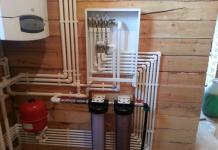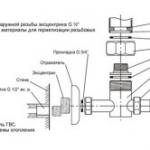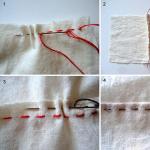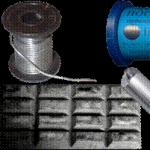Today we’ll talk about how to equip a water supply system in a private house. I have considerable experience in this matter, I am ready to tell you how to draw up a project, select materials and mount the system quickly and efficiently without outside help. With this knowledge, almost any master will cope with the task!

Description of the workflow
We divide the work into 3 parts:
- Calculations and purchase of materials;
- Laying the outer part of the system;
- Laying the inside of the system.
Calculations, design and purchase of materials
Water can be supplied in three ways:
- Taking water from a well. Most often this option is found in rural areas. In this case, a pumping station is installed in the house, which pumps water into the house. A diagram of such a system with an indication of all components is shown below;

- Water intake from a well. The pump pumps water directly from the water source, so there is no extraneous noise in the house, and the system itself consists of simple components that are in every plumbing store;

- Connection to the central water supply. This is the most preferred option, but not every locality has running water, especially when it comes to rural areas. If you are lucky and you can connect to the central system, then your circuit will look something like the figure below.

Now we will analyze the features of drawing up a water supply scheme for a private house with our own hands. There is no universal option here, you must decide in advance where the water consumers will be located and, based on this, draw up an approximate sketch.

Necessary materials:
| Illustration | Description |
 |
Pump. Required if water is taken from a well or well. Its configuration depends on the system and is selected separately in each case. |
 |
HDPE pipe (low pressure polyethylene). It is used for laying the outer part of communications.
|
 |
Fittings for HDPE pipes. The exact number and configuration of components are determined by the project. As an example, use the diagrams that are presented above, it shows in detail where certain fittings are used. |
 |
Polypropylene pipe. Use the reinforced version (the photo shows how to determine it by eye), it is suitable for communications with cold and hot water. The optimal diameter is 20 mm, it is enough even with a large amount of water consumption. The number is calculated according to the length of all pipelines in the house. |
 |
Distribution manifold. It is necessary to maintain the same pressure on all lines of the system. Serial connection without a comb (as the collector is also called) is allowed in small houses where no more than 3 people live permanently. |
 |
Fittings for polypropylene pipes. Calculated according to the system design. Each turn, branch and connection is made by a fitting, so the assortment and quantity are different in each house. |
 |
Fasteners. To fix the pipes, special clips are used, which can be interconnected if you need to run several highways. The elements are fastened to the wall with dowels or self-tapping screws, it all depends on the type of surface. |
Now let's deal with the tool that is needed when doing the work with your own hands:
- Apparatus for welding polypropylene pipes. In common people it is called a soldering iron. This is the main tool with which the installation of water supply in the house is carried out, the price of the simplest options is about 1500 rubles;

- Pipe shears. A special device that allows you to cut plastic pipes at a perfectly right angle. With it, you can cut elements with a diameter of up to 63 mm;

- sharp knife. Sometimes there are burrs on the ends. To cut them, keep any knife handy.
- Composition for degreasing pipes. Alcohol-based solutions are sold, with which the ends of the elements are processed before joining. Also on sale you can find special wet wipes for these purposes.

Laying the outer part of the system
This part of the work consists of the following steps:
| Illustration | Stage description |
 |
Digging a trench. It can go to a well, a well or a centralized water pipe. The depth should be below the freezing point of the soil in your area. If it is impossible to dig to the desired depth, then it will be necessary to lay the pipe in a special one. |
 |
If you have a well, then the pipe is connected to the pump. This is done simply and quickly with the help of a special fitting. The power cable is attached to the pipe using plastic clamps. |
 |
If you have a well, then an intake pipe is placed. It is attached through the knee, a strainer is placed at the end to protect the system from sand and other impurities. |
 |
Tapping into the central water supply is made using a coupling. It is put on the pipe, after which a hole is drilled and a tap is screwed in. No welding is needed. |
 |
The pipe is laid in a trench. Everything is simple here - the main thing is to carefully lay communications and bring them to the house. Make sure it's long enough. |
 |
The pipe is led into the house. Before you bring it under the foundation, I advise you to insulate that part of the structure that goes up, since it is the water supply to the house that freezes at low temperatures. |
 |
Mounted entrance to the house. A swivel coupling is installed, a crane is attached behind it. Next comes a strainer with a sump and a water meter (if you have a centralized option), followed by a splitter for hot and cold water. If the water supply is from a well or a well, then a meter and a splitter are not needed, a pressure gauge is located in their place. |
Laying the system in the house
Do-it-yourself plumbing in a private house is done as follows:
| Illustration | Stage description |
 |
Soldering iron preparation. To do this, nozzles of the size you need are first placed on the tool, after which it is located on a flat surface or fixed on a tabletop if a clamp is provided in the design. The kit always comes with instructions, be sure to read it to know the warm-up time and other rules for operating the equipment. |
 |
The pipe is cut into pieces of the desired size. First, measurements are made, after which the pipes are marked. You need to cut carefully, holding the tool strictly perpendicular. After cutting, check the ends, if there are burrs, then carefully cut them off with a knife. |
 |
The ends of pipes and fittings are degreased. To do this, use a cloth soaked in a special compound or a damp alcohol wipe. It is important to carefully process the connected areas. |
 |
Welding depth marks are made on the parts to be joined. Marks are placed at a distance of 16 mm from the edge. Before making them, wait for the surface to dry after degreasing. Do not miss this nuance, in order to make reliable plumbing in the house, you must carefully follow the technology. |
 |
Elements are put on nozzles and heated. This should be done on a fully heated soldering iron (when the red light goes out). As for the heating time, if there is no indicator on the tool, the parts must be held for 7-8 seconds and immediately removed. |
 |
Elements connect. The pipe is inserted into the fitting, compressed tightly and held in this position for several seconds. In no case do not turn the pipe, this will reduce the reliability of the connection. When assembling the plumbing with your own hands, look at the connections, they should get polypropylene rollers as in the photo, this is a sign of high-quality soldering. |
 |
Each branch is made separately. The assembly of the water supply system is carried out strictly according to the scheme. It is important to carefully connect each joint to ensure the reliability of the water supply. |
 |
Clips are attached. The pipe is gently shifted to the side, after which fasteners are installed along the line of its location. You can put fasteners in advance. Often, communications for the supply of water in a private house are hidden in, in this case, the strobes are made in advance. |
Do-it-yourself water is laid in the house in 2-3 days. The work is simple and you save a lot of money, because installation often costs almost as much as the materials.

Conclusion
Using the article as an instruction, you can draw up a project, purchase materials and lay plumbing in the house. The video in this article will help you understand the topic even better, and if something is not clear to you, ask your questions in the comments.
Water is needed in all aspects of human life, including household. Before buying a plot for building your dream home, you should think over the water supply system in advance. This issue is more relevant than ever, as the number of migrants from city apartments to the private sector is growing every year.
Conducting water to a private house is not a cheap pleasure, it is better to calculate all costs in advance and stock up on finances. The costs are due to the fact that the process itself is not easy. How much does it cost to install plumbing in a private house? What affects the final cost?
The cost of conducting water to the house of the private sector
 A private house must meet certain technical and domestic requirements. The owners usually strive to bring the living conditions in it closer to those that were in a comfortable apartment.
A private house must meet certain technical and domestic requirements. The owners usually strive to bring the living conditions in it closer to those that were in a comfortable apartment.
And one of the key factors is the water supply in the house. The 21st century is marching around the world, which means that “conveniences on the street” and trips for water to the well are a thing of the past.
The cost depends on which source to choose:
- Main system.
- Well.
- Offline source.
The main water supply is not such a good option as it might seem:
- Unequal availability.
- Insufficient quality of services, for example, low water pressure in the house.
- The connection will turn into paperwork.
- Vodokanal's design service is paid separately (the price may vary from 20 thousand rubles, the amount depends on the region of residence).
It will be much cheaper to conduct a well to a private house, including a battery tank and a pumping station. How much it will cost depends on the depth of the layer and the finishing materials. Spending can be from 5 thousand rubles, installation and consumables are included.
The most expensive option for a private house is offline source. As a rule, this is an artesian well. It justifies the money spent, as it gives access to an unlimited supply of high-quality water.
In addition, it is possible to conduct water in this way without using a pump. Constant pressure in the well causes the fluid to flow to the surface without the use of additional devices.
The cost of the well will be expensive due to the need to register it and drill it to an impressive depth. All work together will cost from 100 thousand rubles and more.
The direct costs of wiring the premises inside a private house depend on the technical design drawn up by specialists. It is also better to entrust all work to professionals.
Well in a private house
 The simplest and least expensive way to provide water to a house is a well. Its installation is not a difficult job, and therefore it will be cheap.
The simplest and least expensive way to provide water to a house is a well. Its installation is not a difficult job, and therefore it will be cheap.
The supply of water in the well is replenished, but as long as it is fed by underground sources. In addition, it must be equipped filtration system and a storage tank to maintain good pressure. Water quality will depend on the type of groundwater.
Wells are exposed to natural precipitation and various runoffs. With all its disadvantages, the well will not require huge costs and will last a long time. Still, the best type of water supply in a private house is an autonomous system.
well for water
 Drilling a well is expensive, but worth it. Wells are divided into two types: artesian and sandy.
Drilling a well is expensive, but worth it. Wells are divided into two types: artesian and sandy.
The second one is cheaper analogue of the first, with its help, water is extracted at a depth of up to 35 meters from sandy aquifers.
This is a good option for a summer residence. Before carrying out such water supply, you should familiarize yourself with its nuances:
- if the sand layer is deeper than 35 meters, then an artesian well will have to be drilled;
- if there are rocks in the soil, then drilling is impossible;
- even if water is extracted from a sandy well in the house next door, there is no reason to believe that drilling on your site will give the desired result;
- the filter will often have to be cleaned due to silt adhering, the filter does not change, in case of complete contamination, a new well is drilled;
- the filter does not provide complete purification, sand gets into the water, which adversely affects the operation of the pump;
- service life depends on the frequency of use in a private house;
- water pollution in the upper layers varies and depends on weather conditions.
But it has one significant drawback, it can be use maximum 7 years. But the artesian well will be used for many more generations. In both cases, water quality is not dependent on any external factors.
Now you know how much it costs to run water in a private house. Of course, everything is decided by the owner of the house, taking into account the available opportunities, including financial ones.
An artesian well is the best option, so it should be considered as a perspective.
Most residents of the private sector deliberately refuse to connect to the main system for objective reasons.
Experts advise take into account all the nuances and their plans for further living in the designed private house when choosing a water supply system. It is better to work out this issue in advance, even at the stage of buying a land plot.
Violation in the modes of functioning of the life support systems of the population is called an emergency. In winter, most often there is a rupture of pipelines with hot and cold water due to its freezing in some areas. This happens due to a violation of the pipe insulation technology or the destruction of the insulation. To prevent this from happening in your home, you need to know how and with what to insulate a water pipe on the street, using the latest developments in this area.
The main heat-insulating material at the dawn of the arrangement of engineering networks of settlements is the earth. Additional pipe insulation was used only for open laying. Subsequently, it turned out that such insulation did not live up to expectations. When the earth becomes wet more than 5 times, its specific thermal conductivity coefficient changes, from 0.2 to 1.1 units.

Soil freezing depth
In addition, laying pipelines in the ground without insulation has a number of disadvantages:
- it is necessary to carry out a large amount of work to prepare a trench with a depth of 20-30 cm more than the depth of soil freezing;
- the presence of moisture and active elements in the ground accelerates the corrosion processes taking place in pipes;
- a large layer of earth exerts increased pressure on the pipe walls, causing its deformation and destruction during long-term operation.
When laying pipes underground, in order to increase the level of thermal insulation, it is necessary to carry out layer-by-layer compaction of the laid soil. In some cases, laying pipes at great depths is simply not possible or not economically feasible. He hopes that a lot of snow will fall on time, and frosts will not exceed the climatic norm in the presence of insulating materials, the height of carelessness. It is necessary to carry out thermal insulation in order to increase the service life of pipelines and reduce energy consumption.
Necessary for high-quality insulation
For the insulation of water pipes on the street, the following materials are used:
- glass wool;
- basalt heaters;
- thermal insulation from expanded polystyrene;
- pipes made of foamed synthetic rubber.




Each of them has its pros and cons, both in the arrangement of insulation and in operation.
We use glass wool
 Glass wool insulation was very popular, but the emergence of new heaters is gradually pushing it out of the market. Its ease of use and low price cannot outweigh its shortcomings:
Glass wool insulation was very popular, but the emergence of new heaters is gradually pushing it out of the market. Its ease of use and low price cannot outweigh its shortcomings:
- low environmental cleanliness;
- insufficient physical density.
When laying, maximum protection of the skin and respiratory organs from contact with the material is necessary. A protective cover is required in order to prevent the reduction of the insulating layer under the weight of the earth. It will also be required when insulating a pipe laid in an open way in order to prevent the destruction of the insulation under the influence of water and wind, as well as to ensure the necessary safety of people.

Before insulating the pipe on the street (if the pipe is made of metal), it is necessary to paint it.
When laying in a trench, the pipe is wrapped with material, pre-fixing it with clamps. Then they wrap it with a layer of waterproofing, fixing it with turns of knitting wire, clamps. For this, roofing felt, roofing felt, metallized foil, fiberglass are used.
Provide protection of the insulation against compression by:
- laying it in a large-diameter pipe that is slightly susceptible to corrosion;
- covering with U-shaped or semicircular elements made of asbestos cement or concrete.
To separate thermal insulation from soil water, it is recommended to provide for the arrangement of a waterproofing layer of sand and gravel.
What should be the optimal insulation
The desire to reduce the cost of housing being built required the pipeline to be insulated with materials that have:
- low coefficient of thermal conductivity;
- long service life in adverse conditions;
- zero water absorption;
- the possibility of multiple use;
- low requirements for the qualification of the installer.
We use basalt fiber
The material is made from natural basalt stone, has a high level of fire, environmental and biological safety. Between the fibers there is a large amount of air that provides insulation.

Basalt fiber insulation for pipes on the street is produced in the form of half-cylinders and cylinders. The former are used when carrying out work on existing water pipelines, the latter - on newly constructed sites. To improve resistance to external influences, the products are covered with a thin layer of aluminum foil. For a reliable hermetic connection of adjacent pieces of insulation, a locking device is technologically provided.
In addition, he:
- has a high density
- UV resistant;
- operated for a long time;
- provides for reuse;
- easy to install.
The quality of thermal insulation is negatively affected by a high degree of water absorption, which is reduced by impregnating the material with hydrophobic compounds. After drying, the quality of insulation is restored. It is recommended to use when insulating an external water supply system on the street using waterproofing.
We use polystyrene foam
Foamed and extruded polystyrene foam is considered an almost ideal insulation for metal-plastic and plastic pipes. A material made of expanded polystyrene contains a large amount of gas in its volume in closed volumes. It has a high degree of fire hazard, low chemical and biological activity. Environmentally friendly.

Available in the form of half-cylinders, providing ease of installation by non-professional installers. He possesses:
- low thermal conductivity;
- almost zero water absorption;
- high mechanical strength in compression and bending;
- service life of 50 years;
- the possibility of repeated use.
The main disadvantage is the low resistance to direct sunlight. It is recommended to use for hidden laying of pipes in the soil layer. Additional waterproofing is not required. Fastening is carried out using construction tape, clamps, wire. Filling the grooves is carried out with mounting foam, followed by painting.
Insulation in is one of the most convenient options for pipe protection.
We trust synthetic rubber
Pipe insulation using foamed synthetic rubber is the most effective method of heat saving in engineering networks. It does not decompose over time, after stretching it restores its shape, does not require additional fixation during installation.
The thermal insulator is a flexible gray or black hose with a longitudinal slit and adhesive applied to it. Production in the form of hollow semi-cylinders with additional aluminum protection has been launched.
It has a number of undeniable advantages. The coefficient of specific thermal conductivity, which decreases at low temperatures, makes it possible to increase the heat-saving capacity. Low water absorption and zero vapor permeability protects pipes from corrosion. Long service life, ease of installation, repeated use, high mechanical density, resistance to tearing and sunlight distinguish rubber pipe insulation from a number of their own kind. A water column insulated with synthetic rubber will not freeze in the most severe frost.
Its use does not require additional measures before insulating a water pipe on the street. It is enough to remove the protective film from the adhesive layer, wrap the pipe with insulation, press the edges for a short time to glue.
Subject to the installation technology, knowledge of the operating conditions of heaters will make it possible to make the right choice of material for plumbing, which provides a warming effect for a long time.
Reliable water supply is the key to comfortable living!
Another alternative way of warming, see the video:
Planning of engineering networks takes place at the stage of building design. The question of how to conduct water in a private house is decided by each owner independently. The best option would be to connect to the central water supply. If a common highway is not available, an autonomous source is selected - a well or a well. The organization of water supply is a complex process that includes several stages. With a little effort and perseverance, you can handle it on your own.
Ways of water supply of a private house
If a central water supply is laid next to the site, then you will not have to look for options on how to connect water to a private house. Eliminate the laborious work of digging a well or well. Tapping into the highway must be authorized by the relevant organizations. To do this, with documents for the right to own the site, they turn to the water utility, where they receive technical specifications. Based on the technical specifications with the tie-in point, pipe section and other nuances, the licensed organization draws up a project. The received project and estimate documentation is certified by the SES. The connection is carried out by a company that has received a license for the installation of water supply. After tapping and connecting the pipeline to internal communications, representatives of the water utility draw up an act of commissioning. It remains only to conclude an agreement with the enterprise, according to which payment will be made.
Water supply of a private house
Attention. The only front of work that is allowed to be done independently is digging a trench, arranging a sand cushion and burying.
Advantages of centralized water supply:
- The price of connecting to the water supply is much lower than the services of a well installation company.
- The scope of work is limited to digging a trench.
- Provides year-round water supply without seasonal fluctuations.
Like any system, centralized water supply has disadvantages:
- Poor quality (presence of iron, chlorine, pollution).
- Weak pressure - often the pressure in the system is not enough to use plumbing. In this case, you will have to install a pump.
 Insertion into the central water supply
Insertion into the central water supply
The choice of material for the pipeline
Water supply to a private house is carried out by a separate branch of the highway. The material for it is selected at the design stage. Possible options include:
- steel;
- plastic;
- metal-plastic.
Products are required to ensure the safety and hygiene of drinking water.
Steel pipes - a classic version of the installation of water supply. They are durable and strong, but corrode over time. The process of connecting products requires threading or welding. Both activities are complex and time consuming.
Polymer pipes (HDPE or polypropylene) - are neutral to any chemical attack, not afraid of corrosion and decay. The service life of materials is up to 50 years. They are not afraid of frost, provide a tight connection when welding or using fittings.
 Polymer pipes
Polymer pipes
Due to their smooth surface, metal-plastic pipes provide high flow permeability. They are a combination of the positive qualities of metal and plastic. Products are resistant to rust and ultraviolet, but are afraid of high temperatures. Maximum water heating 95 0 .
Advice. For welding polypropylene pipes, a special electrical device is used. A large number of connections will require certain skills in working with a welding machine.
 Metal-plastic pipes
Metal-plastic pipes
The design estimate includes the required number of pipes and their estimated cost. The diameter of the pipeline is no less significant than the material. It allows you to provide a normal flow rate and the use of water at the same time by two or more consumers. The length of the line affects the optimal cross-section of pipes:
- up to 30 m - D 25 mm;
- more than 30 m - D 32 mm.
Technology of laying water pipes
To ensure the supply of water all year round, the pipes are laid in a trench dug to a depth below the freezing point of the soil. This indicator, depending on the region, is 1.5-2 m. If the features of the site do not allow laying pipes to a considerable depth, they are insulated with shells made of expanded polystyrene, basalt wool or foamed polyethylene.
At the place of entry into the house, a manhole is constructed or a pipe is led through the foundation into the room. When insulating, the entry point is given special attention, this is the most unprotected area.
 Insulation of the pipe entry point
Insulation of the pipe entry point
Organization of autonomous water supply
If there is no central water supply, then the water supply of a private house with their own hands is organized from an individual source. The work can be divided into several stages:
- Arrangement and buildup of a well or well.
- Installation of outdoor plumbing.
- The device of the internal part of the engineering system.
The most functional way to bring water to a private house with your own hands is to use an automatic system. It includes:
- source of water intake;
- pump equipment;
- hydraulic accumulator;
- filters;
- automation;
- pipeline network;
- stop valves;
- water heater.
 Well water supply scheme
Well water supply scheme
Advice. A shut-off valve is installed in front of each equipment, this will allow for the repair and replacement of system components.
The water pumped by a submersible or surface pump is brought to the house with plastic pipes. A membrane tank is installed to ensure constant pressure. Liquid is injected into it, and after it is disassembled, the float mechanism turns on the pump for refilling. Water is introduced into the house by pipes laid in a ditch with a depth of more than 1.2 m. During the installation, a slope towards the well is observed.
Pipe layouts
Water supply to the points of analysis is carried out in two ways:
- consistent;
- collector.
Series circuit
A house or cottage with a small number of residents is equipped with a water supply system with a serial (tee) connection. All plumbing points are connected from one pipe. Installation requires a small amount of materials, so it will be cheap. Sequential installation leads to a decrease in pressure at the last points of water intake - this is the main drawback of the scheme.
Wiring around the house is carried out with plastic or metal-plastic pipes. This option has many advantages over metal products:
- simple installation;
- no corrosion;
- do not affect water quality;
- durability;
- low cost.
Advice. With parallel arrangement of cold and hot water, the cold pipe should be located lower.
Collector scheme
Collector installation involves the installation of a distributor, from which each point is fed by a separate pipe. To implement the scheme, a large amount of material will be required, but a stable pressure will be maintained in the system.
Attention. If a hot water supply device is planned, then the installation of two collectors will be required.
 Water supply pipe layouts
Water supply pipe layouts
Installation rules
- Installation of water supply in a private house is recommended with a deviation from the wall by a few centimeters (2-3).
- For competent pipe routing, you will need high-quality shut-off valves, corners, tees and other elements.
- Experts advise avoiding the passage of pipes through the walls, if this cannot be avoided, then a glass device is necessary.
- Pipes are laid with a slope towards the drain valve.
- Pipes are fastened in 2 m increments, special clips are used.
Water supply options in the country
The urgent need for organizing water supply to the dacha is obvious to every owner of a suburban area. Water allows not only to carry out watering, but also to live comfortably in the house. The source of water supply in the suburban area is usually a well or well. The question of how to conduct water in the country to the house is decided depending on the seasonality of living outside the city. If operation occurs only in the warm season, then the summer version of the water supply is recommended.
The plastic pipeline is laid in trenches of small depth and is brought out near the wall of the house. Inside, the pipe passes through a hole in the wall or foundation. The main requirement for summer plumbing is the ability to drain water before winter conservation.
The winter version will require much more effort. Pipes are laid to a depth of up to 1.5 m. All components of the water supply: a well (well), a pipeline, pumping equipment - require thermal insulation. Be sure to install a check valve to drain the water.
 Winter water supply scheme
Winter water supply scheme
Advice. In some cases, the pipes cannot be lowered to the required depth. In such a situation, the heating cable will protect against freezing.
Having figured out how to make water supply in a private house, you can save on the services of specialists. This is a significant amount that will come in handy for the purchase of building materials.
Tapping into the city water supply network on your own, without the participation and approval of city services, is prohibited: the main networks are pressurized.
To ensure the authorized connection of drinking water from the city water supply network, it is necessary to perform a number of actions, following a certain procedure and the requirements of the law on water supply and sanitation.
 First of all, you should get a situational plan of the site with the application of all underground utilities. At the same time, the latest version is needed, which is available in the regional geodetic service - it is here that all surveys are handed over after the laying of the next section of underground networks. If the owner of a private house has such a plan, then it is important to make sure that it is suitable, and at the same time it is made on a scale of 1:500.
First of all, you should get a situational plan of the site with the application of all underground utilities. At the same time, the latest version is needed, which is available in the regional geodetic service - it is here that all surveys are handed over after the laying of the next section of underground networks. If the owner of a private house has such a plan, then it is important to make sure that it is suitable, and at the same time it is made on a scale of 1:500.
In addition to the situational plan, you will need to prepare:
- certificate of ownership of the site (or the right to use the land);
- application to the local water utility;
- technical conditions from the mountains. water utility.
The application is made in free form, with the following text:
« To connect a private house located at such and such an address to the city water supply network, I ask you to issue those. conditions».
Often, the water utility company issues ready-made application forms. You need to address your application to the head of the water utility, sign, date and list the attachments, these are copies of the situational plan and the title document for the land.
You will need to fill out a questionnaire - a standard document in which the user indicates how many tenants permanently reside, what dignity. those. appliances will be installed. This will help specialists determine the normative water intake for this residential building. Vodokanal specialists will register the application and explain when to come for ready technical services. conditions.
What does the federal law on water supply and sanitation say?
Those. conditions, in accordance with the federal law on water supply and sanitation, contain instructions:
- regarding the amount of permitted water withdrawal for a given water user;
- the number of the well from which you can connect to the highway;
- turnaround time.
Then, an application should be sent to the district SES with a request to issue an opinion on connection to the city water supply network. Obtaining an opinion from SES specialists is a signal that the first stage has been completed.
Drawing up project documentation
 Designing the water supply of a residential building is a serious matter that people who are far from designing engineering networks should not undertake on their own. It is necessary to order a project to a specialized company that has the proper degree of accreditation, and most logically - to the project team of the same water utility. To the order, except for the situation, site plan and those. conditions, drawings of a residential building are also needed, and not only the plan of the first floor and basement, but also sections.
Designing the water supply of a residential building is a serious matter that people who are far from designing engineering networks should not undertake on their own. It is necessary to order a project to a specialized company that has the proper degree of accreditation, and most logically - to the project team of the same water utility. To the order, except for the situation, site plan and those. conditions, drawings of a residential building are also needed, and not only the plan of the first floor and basement, but also sections.
If you are far from designing engineering networks, order a project from a specialized company, and most logically, from the design team of a water utility.
The project consists of the following components:
- graphic part with an explanatory note;
- custom specification;
- estimates with a statement of resources.
If the owner of the mansion has a construction education, and the track is small, then it is quite possible to make a water supply project for a country house yourself:
- plan;
- longitudinal profile with detailing of the entry points into the building and adjoining to the existing well.
Particular attention should be paid to the technology of excavation, highlighting the nodes of intersections with existing underground utilities, providing for their protection from damage. It is also necessary to draw up a bill of quantities.
It is important to understand what the slope should be, from what materials and what diameters it is best to take pipes, what shutoff valves should be used. With independent design of water supply systems, there will be no estimate. Project documentation is sent to the water utility for approval.
The finished project should also be registered with the SES, where the conclusion was previously issued. Now you can order a topographic survey, that is, a drawing of the area with specification of the distances between buildings, trees, fences up to the existing water well, from which water intake is allowed. The shooting is carried out by surveyors at a scale of 1:500, with the application of underground networks. Using this survey and the project, it is possible to fix the axis of the future route on the surface of the earth, earthworks will be carried out along this line.
Laying and connection works
 The next most important stage is excavation, for which the City Administration receives an application - a form in 2 copies. to obtain a permit, and in the utilities, whose networks pass through the site, an order should be issued. Further, for earthworks, you need to contact a specialized company that has not only all permits for its activities, but also all the mechanisms that will be used. Such a company has gained experience in exactly how to organize and carry out such work: it will be necessary to call in place representatives of those city services whose communications fall into the zone of laying the water supply route, as well as comply with the requirements of external water supply networks, labor protection and safety.
The next most important stage is excavation, for which the City Administration receives an application - a form in 2 copies. to obtain a permit, and in the utilities, whose networks pass through the site, an order should be issued. Further, for earthworks, you need to contact a specialized company that has not only all permits for its activities, but also all the mechanisms that will be used. Such a company has gained experience in exactly how to organize and carry out such work: it will be necessary to call in place representatives of those city services whose communications fall into the zone of laying the water supply route, as well as comply with the requirements of external water supply networks, labor protection and safety.
If the length of the route is from a dozen or two meters, and at the same time the site is densely dotted
- underground pipelines,
- electrical cables,
- communication wires,
it is possible that the use of earth-moving equipment will be impossible. In this case, the work is carried out manually, in the presence of representatives of the relevant city services.
The finished trench should have the geometric parameters indicated in the project, and the walls of the house and the well should be bare, cleared of the ground and prepared for insertion. A tie-in into an existing water supply system is entitled to be performed only by employees of the water utility:
- they turn off the water supply to this well;
- connect the new pipeline to the main one, according to the water supply scheme of a private house.
The company that installs the pipe installs all design taps, plugs, valves, revisions, and other valves, as well as metering devices.
A tie-in into an existing water supply system is entitled to be performed only by employees of the water utility.
Now the network is almost ready, but specialists from the water utility operation service must accept the facility, checking it for compliance with the requirements of 416 FZ on water supply and sanitation, as well as SNiP, only after signing the act it will be possible to backfill the trench. The owner can already call a representative of the subscriber department to seal the meters.
Issue price
The cost of the entire complex for external water supply depends on many factors, including the following:
- track length;
- pipe material;
- laying depth - the volume of excavation depends on it;
- local rates, etc.
The order of the numbers is:
- water supply project - 5 thousand rubles;
- getting those. conditions - 4-5 thousand rubles;
- approvals - 12 thousand rubles;
- the cost of pipes, water meter, components - 5-10 thousand rubles.
- tie-in with a fee for connecting to the network - 15 - 50 thousand rubles;
- excavator work - 5-10 thousand rubles;
- network laying (in the complex) - 1.7 - 2.6 thousand per 1 pm.
Tariffs for water supply by region vary greatly, and in addition to the cost of the tie-in itself, they also charge a tariff rate for the length of the water supply network. Depending on the climate zone, it will also be necessary to provide for thermal insulation measures, and this applies to both entering the house and exiting the well, and the pipeline itself with water supply equipment. Backfilling of trenches is usually done with sand (partially or completely), and this is another plus to the total amount.
The issue price can be from 80 to 120 thousand rubles.
Samples and cost of documents
 In order for the local water supply network to be put into operation, it is necessary to prepare technical as-built documentation in accordance with the standards for water supply (external networks and structures). Such papers are prepared by engineering and technical staff of those companies that performed the work. Acts for hidden work - a special type of primary executive documents, certifying each operation, each layer, which, when performing the next technological construction work, will cease to be visible, that is, become hidden.
In order for the local water supply network to be put into operation, it is necessary to prepare technical as-built documentation in accordance with the standards for water supply (external networks and structures). Such papers are prepared by engineering and technical staff of those companies that performed the work. Acts for hidden work - a special type of primary executive documents, certifying each operation, each layer, which, when performing the next technological construction work, will cease to be visible, that is, become hidden.
For acts of hidden work, there is a special form of forms where you need to enter the necessary information. The act of covert work on the excerpt of the trench should include information on how the excerpt was carried out - mechanized or manual, what soils the earth is represented by. It is necessary to indicate the parameters of the trench, if there are intersections, describe with which particular communications there was an intersection, what measures were taken to protect them.
The act of hidden work on sand filling gives an idea of the thickness of the bedding layer, which is important: sand is a bed for the pipeline. It is also important to demand such acts for hidden work on sp water supply:
- pipeline laying;
- hydraulic testing of the pipeline;
- backfilling the pipe with sand;
- backfilling of trenches.
In addition to these documents, the contractors are required to provide the customer with:
- executive survey of the water supply system - a scheme of water supply and sanitation;
- certificate for the installation of a metering device - a water meter.
But that's not all: the SES service must flush the system and disinfect it, and then check the quality of the water by taking samples. Having issued a special act, the SES gives a signal to supply water to a private house. The presence of an act from the SES on washing and disinfection is a necessary attribute in the package of documents for supplying water to a private house.
The presence of an act from the SES on washing and disinfection is a necessary attribute in the package of documents for supplying water to a private house.
All these papers, upon completion of work, must be submitted to the city water supply metering service for technical examination for compliance with the project and all standards. After this procedure, a certificate of execution of those will be issued. conditions. To be able to supply water, it is necessary that the user's relationship with the water utility for the operation of the water supply system of a private house be formalized. In the office of the municipal enterprise for water there are standard contracts, the owner of the house with a passport and a full package of papers goes there and signs a prepared contract for those. supervision in 2 copies.
Conducting water to a private house, crashing into the central water supply - the procedure is not particularly complicated, but associated with the execution of a large number of all sorts of documents. In order for everything to be done quickly and in compliance with the requirements of the federal law on water supply and sanitation, a specialized company with considerable experience and all permits should be involved in the performance of work.
The video tells the main points about connecting to the water supply and sewerage:



















